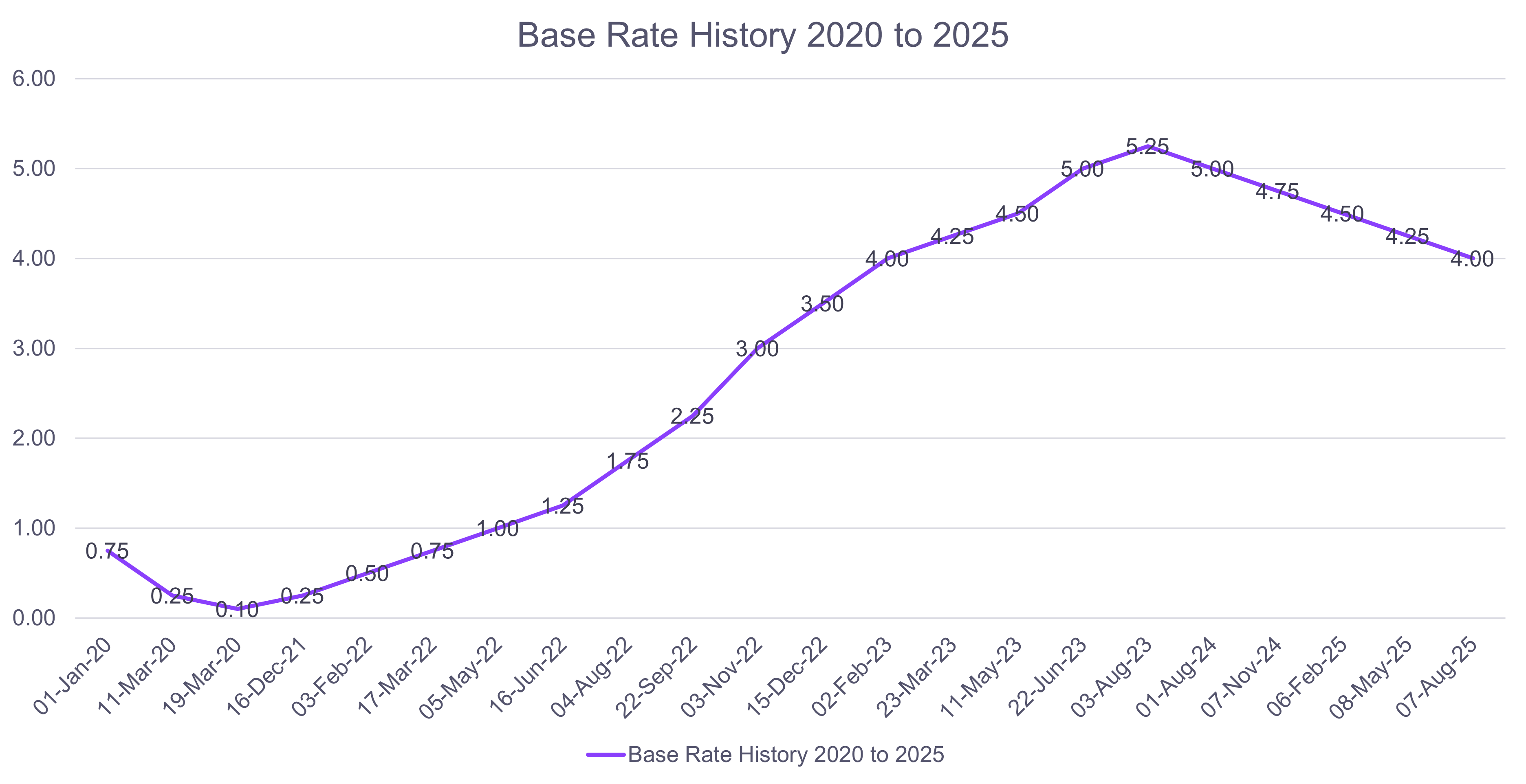Our cash management team is naturally interested in, dare I say it, interest rates, so it goes without saying that we were eagerly awaiting the Bank of England’s Monetary Policy Committee (“MPC”) decision on 7th August.
The bank rate (or what we more commonly refer to as the base rate) has historically followed a cyclical path – that is, a regular series of downward movements during times of economic sluggishness followed by a regular series of upward movements during economic buoyancy. This script was ripped up in 2008 after the sub-prime debt crisis. Names such as Northern Rock, Bank of Scotland, Royal Bank of Scotland and Lloyds Bank were all affected and the potential negative economic impact forced the Bank of England to slash base rate to 0.5% - at the time, an unheard-of all-time low. At that point, the cyclical nature of base rate movements ceased and stayed below 1% from 2009 to 2022. This period included Brexit and the Covid pandemic. The Brexit referendum took place on 23rd June 2016, and on 4th August that year the Bank of England cut base rate to 0.25% because of fears that the vote to leave Europe would have a huge negative economic impact. The Covid pandemic also had a potentially huge negative economic impact and on 19th March 2020 base rate was cut to 0.1% - a new all-time UK low at a time when other countries actually implemented negative interest rate monetary policies.
In the latter stages of the pandemic, government support in most developed economies drove a surge in consumer confidence, driving up demand at the same time that manufacturers were struggling to fulfil orders. This led to an inflationary surge, which central banks belatedly tried to combat by rapidly raising interest rates. To seasoned financial market participants, this heralded a return to the normal cycle of interest rate rises followed by interest rate decreases. Younger and newer (or more optimistic) financial market professionals aren’t used to higher interest rates and fully expect base rate to be cut back down to the more “normal” 0.5%-1% they had got used to. This dichotomy of experience and expectations presents an intriguing paradigm – that is, will base rate return to a traditional cyclical pattern or was the recent post-pandemic flirtation with 5% simply an aberration to be replaced by the Mark Carney era of 0.5% base rate regardless of economic data, be that inflation, employment, wages, housing and GDP.
A snapshot of recent base rate activity is shown in the chart below:-

Returning from our time-travels to the present, we are pondering what to make of the latest Bank of England (“BoE”) move. The cut from 4.25% to 4% on 7th August was the fifth cut since base rate hit 5.25% on 3rd August 2023 and the consensus was confident that the next BoE move would take base rate below 4% and steadfastly down towards 3% and possibly even lower. And why not?
However, there was quite a surprise in the voting pattern. For the first time in many years, there had to be two votes. The first vote by the Monetary Policy Committee (“MPC”) resulted in a three-way split with four for no change, four for a 0.25% cut and one for a 0.5% cut. Under the MPC rules, a second vote was needed to achieve a working majority; the outcome was four for no change and five for a 0.25% reduction to 4%. The real eyebrow raiser was the unexpectedly large number of rate setters, including the Chief Economist and the Deputy Governor for Monetary Policy, who voted for no change.
Markets decided this was a “hawkish” cut, so interest rates at the longer end of the cash yield curve, 12-months, rose by about 0.1%, which is contrary to the presumed outcome when the Central Bank eases monetary policy. True, rates at the very short end of the yield curve, overnight to one-month, eased lower to mirror the rate which the BoE will pay on the reserves commercial banks must place with the Bank but the hawkish message left some commentators wondering if 4% base rate is as low as the Bank will go in this cycle before it starts to rise again. Our feeling is that thoughts of base rate rising are premature. The UK government has been struggling to instil confidence in its economic plans. Several policy U-turns have left markets, voters and political opponents sceptical that the UK economy will deliver the growth the government desperately needs to bring down the budget deficit. Fortunately, for the Labour Party, there is some good news.
First, consumer confidence is good. Retail sales continued their run of solid growth in July, according to the British Retail Consortium, with total sales value stronger by 2.5% on an annual basis.
Second, fears that job growth was weakening have been calmed. A recent Labour Force Survey revealed that employment rose by 238,000 quarter-on-quarter June, above the consensus of a 185,000 gain. Further, the headline unemployment rate was unchanged at 4.7%, raising hopes that businesses are starting to recruit again.
Third, and great news for the government, was the very recent strong GDP growth in the first half of 2025. The data showed that GDP rose 0.4% month-to-month in June, up from a 0.1% fall in May, and above the consensus of a 0.2% gain. The August Monetary Policy Report showed that the BoE’s MPC anticipated growth of just 0.1% in Q2, so their expectations were well beaten. Had this GDP data been available before 7th August MPC meeting then the base rate decision to cut may not have happened. This brings to mind Jon Pope’s recent article highlighting an ING note suggesting there are “good” and “bad” interest rate cuts. ING defined a good interest rate as one sanctioned because of falling inflation, whereas a bad cut was one needed because the economy is in dire trouble. In the UK, it seems that inflation is not falling and the economy isn’t in the dire straits the media seems to think.
The recent GDP news strengthens government claims that the UK economy is one of the strongest in the G7 group and perhaps suggests that if this growth continues, then the MPC will be constrained from cutting rates further and that the next move in rates will see the cycle turning upwards once more.
Possibly a cash manager being too optimistic, but maybe influenced by the sentiment in the line “money for nothing and chicks for free” by the aforementioned band, Dire Straits!


